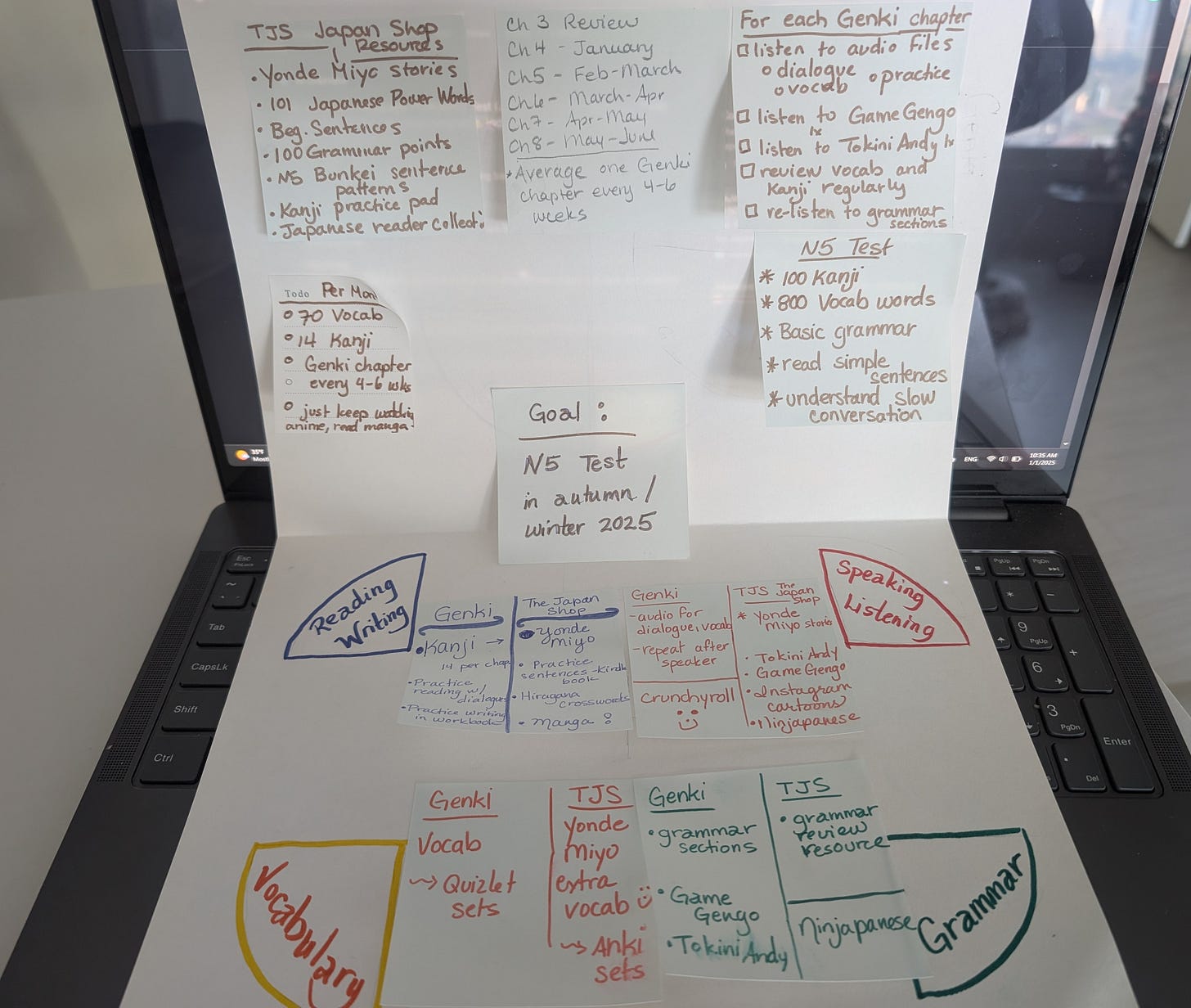In the previous post, I’d begun talking about our Japanese Plan for 2025.
The Japan Shop resource bundle filled in what I find lacking in Genki—help with the reading and writing portion. Designed for college students, really, Genki moves fast over hiragana and katakana ( you’re expected to learn them in the first three chapters) and hits 14 Kanji a week. While there are some workbook exercises, I think they are SUPER dry and boring. And I’m an adult! I can’t imagine what a teenager feels like when they see the black and white pages full of tiny script.
(People, learning to read Korean and Japanese is why I now own a four-pack of old lady reading glasses. The tiny translations under hiragana, the miniscule furigana over Kanji? Good grief. They need to include a magnifying glass with each book purchase. Even my son will complain it’s unreadable.)
First, I’d like to note: we use two YouTube / Patreon channels as our ‘lecture’ portion: Game Gengo and Tokini Andy. Why two? Game Gengo is the ‘cool’ one that explains everything with video games (he does a freaking fantastic job at it, too) but sometimes you just need to hear it another way. Tokini Andy also gives great explanations. Both have free and membership options; e.g. we follow Game Gengo on Patreon.
We don’t get bogged down in the Genki workbook, but switch over to The Japan Shop products, which has a great section of:
Beginner sentence exercises (PDF or Kindle versions. I LOVE the Kindle versions because they’re easy to have on your phone and pull up when on a long subway or bus ride.)
Yonde Miyo stories: I love these! The person who designed these actually KNOWS what it takes to teach your brain to read in another script. The stories are short, and come with an audio that has both slow and normal speed options. All the vocabulary is explained, and the furigana is above the kanji.
I use these not only for reading/writing practice, but also vocabulary. Akshay has a small notebook where he collects his Yonde Miyo vocab for review—he picks 1-2 words per story, not all of the unknown words.
N5 Sentence Patterns (we haven’t used these last three yet)
Japanese Reader Collection
Makoto, their magazine
I also mentioned ‘Ninjapanese’ as a YouTube channel we use. She is a native speaker, unlike the other two channels I mentioned, and she has a great energy in her videos. She is worth a follow, and at some point, I’ve got her paid program in the back of my mind, if we want to switch things up.
Wait, switch things up? What happened to all that Slow and Steady stuff? Yep, I believe that. But I also learned from my son’s experiences in Waldorf and speech therapy, that while change is hard, it can also be refreshing. Like rearranging furniture or a fresh coat of paint. A new teacher can reinvigorate the process.
Does my pie chart always have to be four equal parts?
Nope. Its a circle and infinitely flexible, and someone can even eat a piece and leave only three :)
For example, there are times when people would make reading/writing a smaller or ‘eaten’ piece of the pie if they’re learning to just speak and understand. I know a few people who don’t want to learn the Japanese scripts, and I also have family who speak and understand Hindi but can’t read or write the script. So that part of the pie just *swish* disappears. No shame, no guilt.
Other times, you can cut the pieces to fit your need. For example, when learning hiragana, the read/write portion could be much larger while you focus on that, then it equals out once you know hiragana, some katakana and begin with the kanji. When Akshay was starting out with the scripts, we spent WEEKS on just learning those—writing, flashcards, etc.
I keep reminding learners, Japanese script is this MASSIVE hurdle at the beginning. But it is so WORTH IT! Keep going! (In contrast, Korean hiragana is easy to learn but there’s this hurdle between easy beginner and getting to advanced beginner that is hard.)
LANGUAGE LEARNING APPS
This pie chart helps me emphasize why apps just don’t cut it for learning a language. That annoying, shame-inducing green bird and others teach vocabulary. They may work in some verb conjugation here and there, but many kids will memorize it and not understand what’s going on or why it’s like that. (I can get on a soapbox here, I was using a popular app for a bit and the ‘gamification’ seemed to rely too much on shame and guilt. Totally unhelpful and it sets kids up to think about learning in some unhealthy ways.)
Can apps be helpful? Sure. I already had a B.S. degree in Spanish when I was going to Portugal and wanted to get some Portuguese, for fun. I used Memrise and felt like I made a lot of progress, knew a couple hundred words and a lot of useful phrases for my trip. But without the base of Romance Language grammar and being able to conjugate verbs in Spanish, it would not have been so helpful. They have their usefulness.




